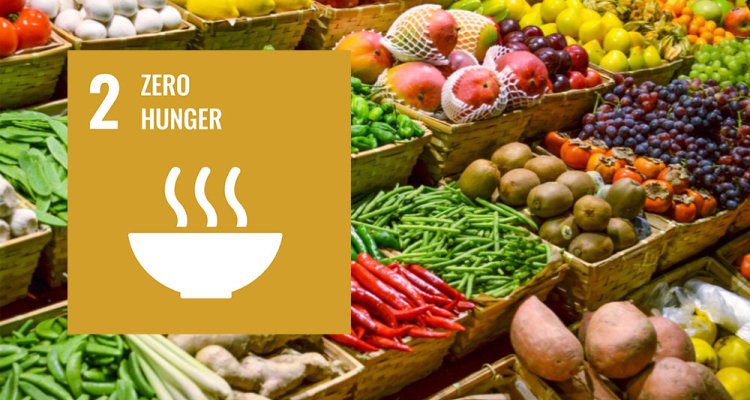
2. Zero hunger
The world population is increasing rapidly and is expected to hit the 9 billion mark in 2050. In less than forty years, two billion more people will need food, housing and jobs. There is no single simple solution. Sustainable food security calls for a multi-disciplinary approach.
Much has yet to be done to meet the demand sustainably—quite the challenge, considering that farmland will not increase. In fact, climate change and population pressure are likely to cause a decline in the available farmland. An added difficulty is the increasing scarcity of water, phosphate and, for example, fuel. There are various paths we can take to achieve the necessary transitions towards a sustainable, affordable, reliable and high-value food system capable of meeting the varying and increasing demand.
Focusing on production is a logical choice. The Growth Yield Gap Atlas shows the potential yield of existing farmlands. Thus making it clear precisely where investments in technical and agricultural development would be most effective. Programmes such as N2Africa (nitrogen) or Manos al agua (water) work to enhance local production through smarter and better management of natural resources.
A more technical solution is found in the most fundamental process in the entire food supply: photosynthesis. The efficiency of this elementary process through which water and carbon dioxide are transformed into carbohydrates and oxygen through sunlight is still relatively low in many plants. In the Photosynthesis 2 programme, 51 institutes across the globe collaborate to improve the efficiency of photosynthesis.
In addition to improving food production, there is still room for improvement in the post-production stage. No less than 40% of the world’s food production is wasted during production, transportation, or in consumers’ households. In the Netherlands, an average of 34 kilogrammes of good food is wasted annually per consumer. There are numerous ways to prevent food waste.
Sustainable Development Goal 2 (Zero Hunger), or food security, is about more than just hunger. It is also about malnutrition and overnutrition (obesity). In addition to 800 million people suffering from hunger, the FAO estimates 1 billion people are malnourished due to vitamin or mineral deficiencies. Moreover, just under 2 billion people are overweight, of which 650 million are obese. Research on consumer behaviour is critical. Consumer behaviour is also a relevant factor in the protein transition, as are technological aspects such as meat substitutes. The ‘Agriculture for Health & Nutrition (A4NH)’ programme studies the potential of agricultural development for gender-neutral health and nutrition for the disadvantaged.
There is no single, unambiguous path towards a world without hunger. But by focusing on integrated policies, interdisciplinary research and collaboration with governments, private parties and research institutes, we work on sustainability goals such as climate-smart food systems.
Our goal: to end hunger, achieve food security and better nutrition and advance sustainable agriculture
Stay updated about activities and news of the Sustainable Development Goals at WUR:
Examples of WUR projects
N2AFRICA
N2AFRICA is a large-scale scientific ‘research-in-development’-project that focuses on nitrogen compounds on the legume acres of small-scale African farmers. We focus on the creation of sustainable, enduring partnerships through which African farmers may benefit from the symbiotic nitrogen compounds from legumes through effective production methods such as inoculation and fertilisation. The project, which is led by Wageningen University & Research, has a duration of five years and is a collaboration with the International Institute of Tropical Agriculture (IITA) and the International Livestock Research Institute (ILRI), as well as many partners throughout Africa. N2Africa has reached over 230.000 small-scale farmers that have experimented with and applied improved legume varieties, Rhizobium-inoculation and phosphate fertilisers.
Banana cultivation
Bananas are a staple food for over 400 million people living in the tropics. It is the fourth most consumed food crop and the most consumed food that is not based on grain. Moreover, it is the most consumed fruit in the world. The global banana crop is, however, gravely threatened by pervasive fungal diseases, of which the Panama disease and the black Sigatoka disease are the most important. These diseases threaten the livelihood of millions of people. The public-private collaboration programme PromoBanana focuses on the Philippines, where a professional laboratory based on existing knowledge of Panama disease and black Sigatoka disease is established. The services this laboratory provides enables small-scale and large banana growers to identify diseases at an early stage and prevent them from spreading, as well as improving fertilisation.
- Banana cultivation
Traditional fermented foods to promote food and nutrition security in Africa
This project targets the promotion of food and nutrition security in Africa by ameliorating the quality and use of traditional fermented foods by strengthening the connected local value chains through fostering women entrepreneurship. Fermented foods are characterized transformation of raw materials by microorganisms makes foods generally safe, highly nutritious and sensory attractive with an increased shelf-life, while creating entrepreneurship opportunities for local women. So far efforts to combat hunger and malnutrition have largely overlooked the potential of the improvement of local food processing and optimization of the concerned value chains. Hence, making upgraded fermented foods the subject of efforts to stimulate (women) entrepreneurship is expected to have a direct effect on food and nutrition security by making improved fermented foods more available as well as an indirect effect through income generation to support livelihoods.